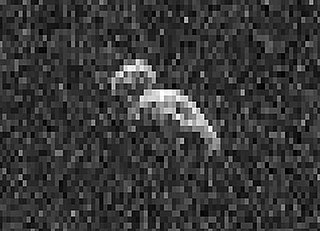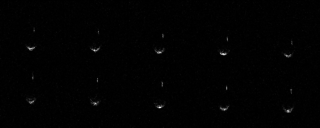
A near-Earth object (NEO) is any small Solar System body whose orbit brings it into proximity with Earth. By convention, a Solar System body is a NEO if its closest approach to the Sun (perihelion) is less than 1.3 astronomical units (AU). If a NEO's orbit crosses the Earth's orbit, and the object is larger than 140 meters (460 ft) across, it is considered a potentially hazardous object (PHO). Most known PHOs and NEOs are asteroids, but a small fraction are comets.
(89959) 2002 NT7 (prov. designation:2002 NT7) is a near-Earth object with a diameter of 1.4 kilometers and potentially hazardous asteroid of the Apollo group. It has a well determined orbit with an observation arc of 64 years including precovery images by Palomar Observatory dating back to 1954.

(29075) 1950 DA, provisional designation 1950 DA, is a risk-listed asteroid, classified as a near-Earth object and potentially hazardous asteroid of the Apollo group, approximately 1.1 kilometers in diameter. It once had the highest known probability of impacting Earth. In 2002, it had the highest Palermo rating with a value of 0.17 for a possible collision in 2880. Since that time, the estimated risk has been updated several times. In December 2015, the odds of an Earth impact were revised to 1 in 8,300 (0.012%) with a Palermo rating of −1.42. As of 2022, It is listed on the Sentry Risk Table with the second highest cumulative Palermo rating of −2.05. 1950 DA is not assigned a Torino scale rating, because the 2880 date is over 100 years in the future.

Sentry is a highly automated impact prediction system operated by the JPL Center for NEO Studies (CNEOS) since 2002. It continually monitors the most up-to-date asteroid catalog for possibilities of future impact with Earth over the next 100+ years. Whenever a potential impact is detected it will be analyzed and the results immediately published by the Center for Near-Earth Object Studies. However, several weeks of optical data are not enough to conclusively identify an impact years in the future. By contrast, eliminating an entry on the risk page is a negative prediction.
(417634) 2006 XG1 provisional designation 2006 XG1, is a sub-kilometer asteroid, classified as near-Earth object and potentially hazardous asteroid of the Apollo group, that had a low but non-zero probability of impacting Earth on 31 October 2041. The asteroid was discovered on 20 September 2006, by astronomers of the Catalina Sky Survey, using a dedicated 0.68-meter telescope at Mount Lemmon Observatory in Arizona, United States.

(480808) 1994 XL1 is a sub-kilometer asteroid, classified as near-Earth object and potentially hazardous asteroid of the Aten group, approximately 200 meters (700 feet) in diameter. It was discovered on 6 December 1994, by Scottish–Australian astronomer Robert McNaught at Siding Spring Observatory in Australia. It was one of the first asteroids discovered to have a semi-major axis less than Venus.

A potentially hazardous object (PHO) is a near-Earth object – either an asteroid or a comet – with an orbit that can make close approaches to the Earth and which is large enough to cause significant regional damage in the event of impact. They are conventionally defined as having a minimum orbit intersection distance with Earth of less than 0.05 astronomical units and an absolute magnitude of 22 or brighter, the latter of which roughly corresponds to a size larger than 140 meters. More than 99% of the known potentially hazardous objects are no impact threat over the next 100 years. As of September 2022, just 17 of the known potentially hazardous objects listed on the Sentry Risk Table could not be excluded as potential threats over the next hundred years. Over hundreds if not thousands of years though, the orbits of some "potentially hazardous" asteroids can evolve to live up to their namesake.
(153814) 2001 WN5 is a sub-kilometer asteroid, classified as near-Earth object and potentially hazardous asteroid of the Apollo group.

(7482) 1994 PC1 is a stony asteroid, classified as near-Earth object and potentially hazardous asteroid of the Apollo group, approximately 1.1 kilometers in diameter. It was discovered on 9 August 1994, by astronomer Robert McNaught at the Siding Spring Observatory in Coonabarabran, Australia. With an observation arc of 47 years it has a very well known orbit and was observed by Goldstone radar in January 1997. The 2022 approach has been observed every month since August 2021.

(410777) 2009 FD is a carbonaceous sub-kilometer asteroid and binary system, classified as near-Earth object and potentially hazardous asteroid of the Apollo group, discovered on 24 February 2009 by astronomers of the Spacewatch program at Kitt Peak National Observatory near Tucson, Arizona, in the United States.
(242450) 2004 QY2 (prov. designation:2004 QY2) is an asteroid on an eccentric orbit, classified as near-Earth object and potentially hazardous asteroid of the Apollo group, approximately 3 kilometers (2 miles) in diameter. It was discovered on 20 August 2004 by the Siding Spring Survey at an apparent magnitude of 16.5 using the 0.5-metre (20 in) Uppsala Southern Schmidt Telescope. It is one of the largest potentially hazardous asteroids known to exist.
(471240) 2011 BT15, provisional designation 2011 BT15, is a stony, sub-kilometer sized asteroid and fast rotator, classified as a near-Earth object and potentially hazardous asteroid of the Apollo group. It had been one of the objects with the highest impact threat on the Palermo Technical Impact Hazard Scale.
2014 UR116, also known as 2008 XB, is an eccentric sub-kilometer asteroid, categorized as a near-Earth object and potentially hazardous asteroid of the Apollo group with a diameter of approximately 400 meters (1,300 ft). It was first observed on 1 December 2008, by the Mount Lemmon Survey at Mount Lemmon Observatory in Arizona, United States.
2014 XL7 is a near-Earth object and Apollo asteroid, approximately 230 meters (750 feet) in diameter. It was the most dangerous potentially hazardous asteroid on Sentry Risk Table upon its discovery by the Mount Lemmon Survey in December 2014. At the time, the asteroid had a cumulative 1 in 83000 chance of impacting Earth on 4–5 June between the years 2048 and 2084. After the object's observation arc had been extended to 35 days, it was removed from the Sentry Risk Table on 15 January 2015. Since then the asteroid's orbit has been secured. Although it has an Earth minimum orbit intersection distance of less than one lunar distance, there are no projected close encounters with Earth in the foreseeable future, with its closest passage to occur in May 2046, still millions of kilometers away.
2010 GZ60 was originally estimated by JPL to be a near-Earth asteroid approximately 2 kilometers (1.2 miles) in diameter. But is now known to be an asteroid from the inner region of the asteroid belt that does not get closer than 1.5 AU (220 million km) to Earth.
(111253) 2001 XU10, provisional designation 2001 XU10, is an asteroid on an eccentric orbit, classified as near-Earth object and potentially hazardous asteroid of the Apollo group, approximately 3 kilometers in diameter. It was discovered on 9 December 2001, by astronomers of the LINEAR program at Lincoln Laboratory's Experimental Test Site near Socorro, New Mexico, in the United States. The asteroid is one of the largest potentially hazardous asteroids.

(505657) 2014 SR339, provisional designation 2014 SR339, is a dark and elongated asteroid, classified as near-Earth object and potentially hazardous asteroid of the Apollo group, approximately 970 meters (3,200 feet) in diameter. It was discovered on 30 September 2014, by NASA's Wide-field Infrared Survey Explorer telescope (WISE) in Earth's orbit. Closely observed at Goldstone and Arecibo in February 2018, it has a rotation period of 8.7 hours.

(164121) 2003 YT1, provisional designation 2003 YT1, is a bright asteroid and synchronous binary system on a highly eccentric orbit, classified as near-Earth object and potentially hazardous asteroid of the Apollo group, approximately 2 kilometers (1.2 miles) in diameter. It was discovered on 18 December 2003, by astronomers with the Catalina Sky Survey at the Catalina Station near Tucson, Arizona, in the United States. The V-type asteroid has a short rotation period of 2.3 hours. Its 210-meter sized minor-planet moon was discovered at Arecibo Observatory in May 2004.
(85182) 1991 AQ, provisional designation 1991 AQ, is a stony asteroid on a highly eccentric orbit, classified as near-Earth object and potentially hazardous asteroid of the Apollo group, approximately 1.1 kilometers in diameter. It was discovered on 14 January 1991, by American astronomer Eleanor Helin at the Palomar Observatory in California. Based on its brightness variation of 0.69 magnitude, this Q-type asteroid is likely elongated. It belongs to the small group of potentially hazardous asteroids larger than one kilometer.

2018 XB4 (also written 2018 XB4) is an Apollo near-Earth asteroid roughly 53 meters (170 feet) in diameter. It was discovered on 13 December 2018 when the asteroid was about 0.125 AU (18,700,000 km; 11,600,000 mi) from Earth and had a solar elongation of 146°. It passed closest approach to Earth on 1 January 2019. Of the asteroids discovered in 2018, it had the highest Palermo scale rating at –3.6. In mid-2019 it was recovered which extended the observation arc to 177 days and was removed from the Sentry Risk Table on 12 June 2019. It is now known that on 22 June 2092 the asteroid will pass about 0.033±0.015 AU from Earth.














